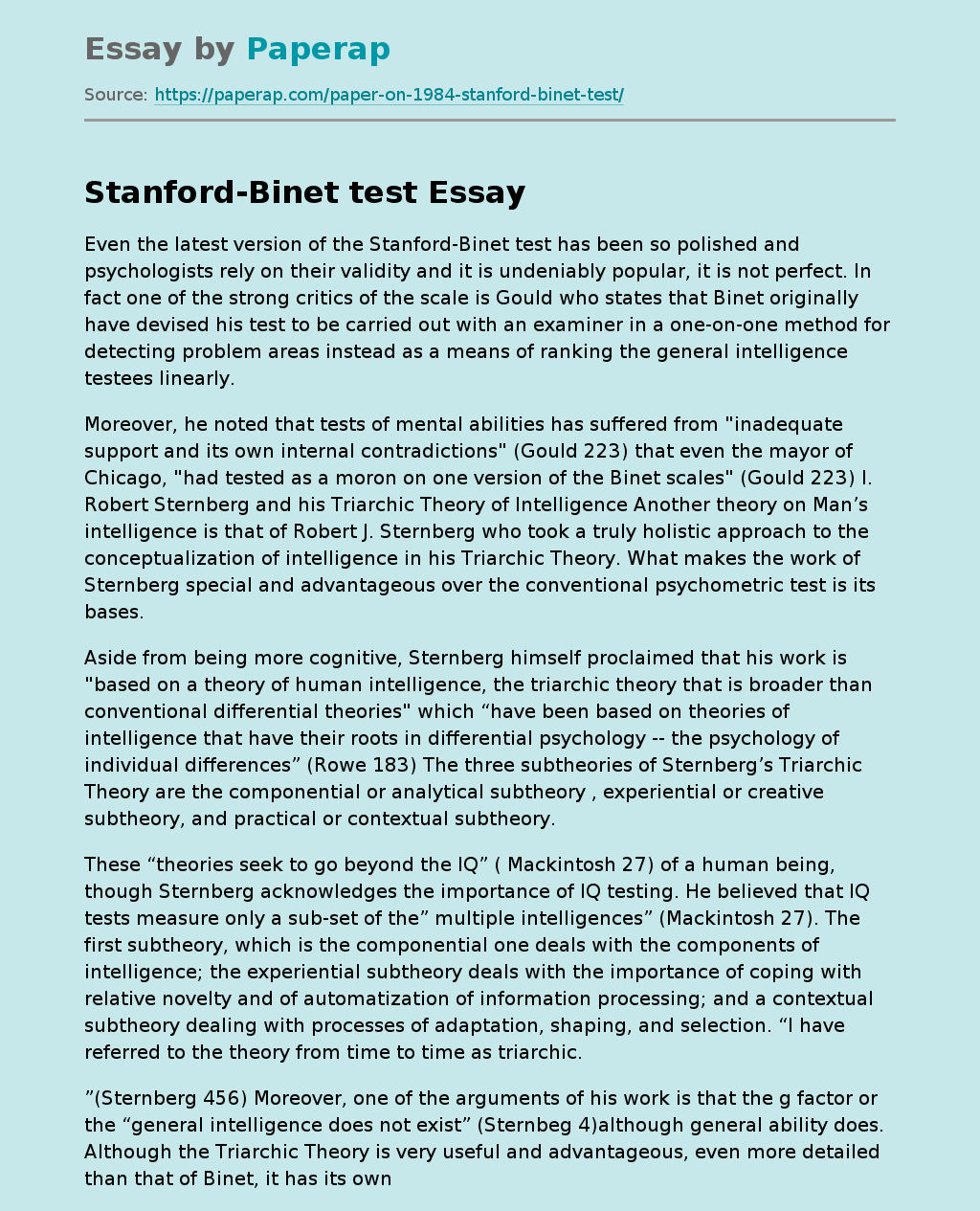Stanford-Binet test
Even the latest version of the Stanford-Binet test has been so polished and psychologists rely on their validity and it is undeniably popular, it is not perfect. In fact one of the strong critics of the scale is Gould who states that Binet originally have devised his test to be carried out with an examiner in a one-on-one method for detecting problem areas instead as a means of ranking the general intelligence testees linearly.
Moreover, he noted that tests of mental abilities has suffered from “inadequate support and its own internal contradictions” (Gould 223) that even the mayor of Chicago, “had tested as a moron on one version of the Binet scales” (Gould 223) I.
Robert Sternberg and his Triarchic Theory of Intelligence Another theory on Man’s intelligence is that of Robert J. Sternberg who took a truly holistic approach to the conceptualization of intelligence in his Triarchic Theory. What makes the work of Sternberg special and advantageous over the conventional psychometric test is its bases.
Aside from being more cognitive, Sternberg himself proclaimed that his work is “based on a theory of human intelligence, the triarchic theory that is broader than conventional differential theories” which “have been based on theories of intelligence that have their roots in differential psychology — the psychology of individual differences” (Rowe 183) The three subtheories of Sternberg’s Triarchic Theory are the componential or analytical subtheory , experiential or creative subtheory, and practical or contextual subtheory.
These “theories seek to go beyond the IQ” ( Mackintosh 27) of a human being, though Sternberg acknowledges the importance of IQ testing.
He believed that IQ tests measure only a sub-set of the” multiple intelligences” (Mackintosh 27). The first subtheory, which is the componential one deals with the components of intelligence; the experiential subtheory deals with the importance of coping with relative novelty and of automatization of information processing; and a contextual subtheory dealing with processes of adaptation, shaping, and selection. “I have referred to the theory from time to time as triarchic.
”(Sternberg 456) Moreover, one of the arguments of his work is that the g factor or the “general intelligence does not exist” (Sternbeg 4)although general ability does. Although the Triarchic Theory is very useful and advantageous, even more detailed than that of Binet, it has its own share of criticisms. Quoting sociologist Linda Gottfredson in Sternberg’s book, is an obvious defense for the validity of the IQ tests. The effects of intelligence–like other psychological traits–are probabilistic, not deterministic. Higher intelligence improves the odds of success in school and work.
It is an advantage, not a guarantee. Many other things matter. is an obvious qualification of the arguments Sternberg has presented and a defense for the validity of IQ tests. II. Psychometric Approach and the Information Processing Approach Psychometrics or psychometry, being the basis of the Psychometric Approach, is “the branch of psychology that deals with the design, administration, and interpretation of quantitative tests for the measurement of psychological variables such as intelligence, aptitude, and personality traits” (The Free Online Dictionary) in testing human ability.
The Psychometric Approach, which presume that intelligence is a measurable factor, has became the “ primary method of studying intelligence” (Corr) and thus the testing of IQ was born. There are many psychologists who devoted their time on studying intelligence and have paved ways in producing a method to measure the intelligence in a psychometric manner. Among them, as previously mentioned, is Alfred Binet with his Binet-Simon Scale. The study of psychometrics was only starting with that of Binet though and its furtherance can be seen in Dr.
John C. Raven’s Progressive Matrices, Kaufman couple’s Kaufman’s Assessment Battery for Children (K-ABC) and in the Wechsler Adult Intelligence Scale (WAIS) . If a one is not following the psychometric approach, that psychologist would be using an Information Processing Approach. This is another philosophical theory in understanding the cognitive process, similar to the applications used by Sternberg in his Triarchic Theory and diverse from that approach of Binet as explained above. This approach views human as an “information processor” (Wyer 2).
The same author further explains the idea of this approach on the character of the information processor as: .. capable of receiving information operating upon it according to certain rules, storing the results of these operations in memory, altering the contents of certain areas of memory to which new information is relevant, and ultimately reporting the results of these operations in a form that is implicitly or explicitly specified by a “user. ” The Information Processing Approach, therefore, is based on the premise that humans have brains that are similar to computers.
III. Conclusion Intelligence is something measurable and all the efforts done to measure it have greatly influenced the foundation and philosophical views on the cognitive process as well as the educational system all throughout the world. No matter what a person chooses to use to understand the cognitive process, any approach is useful and have their certain characteristic that is superior over the other. They have their respective disadvantages over each other as well.
Finally, in measuring the intelligence of an individual, it is not the measurement that matters or the measurement method that was used. The most important is the application of that highly measured intelligence towards the betterness of humanity.
Works Cited
Becker, Kirk. A.. History of the Stanford-Binet intelligence scales: Content and psychometrics. (Stanford-Binet Intelligence Scales, Fifth Edition Assessment Service Bulletin No. 1). Itasca, IL: Riverside Publishing, 2003. Corr, Bradley. “The Psychometric Approach to Intelligence: How Smart am I?. ” Serendep. 2004. Retrieved May 5, 2008
Stanford-Binet test. (2017, Jun 07). Retrieved from https://paperap.com/paper-on-1984-stanford-binet-test/

